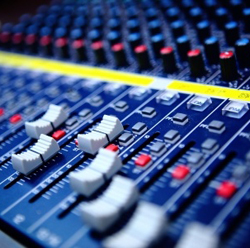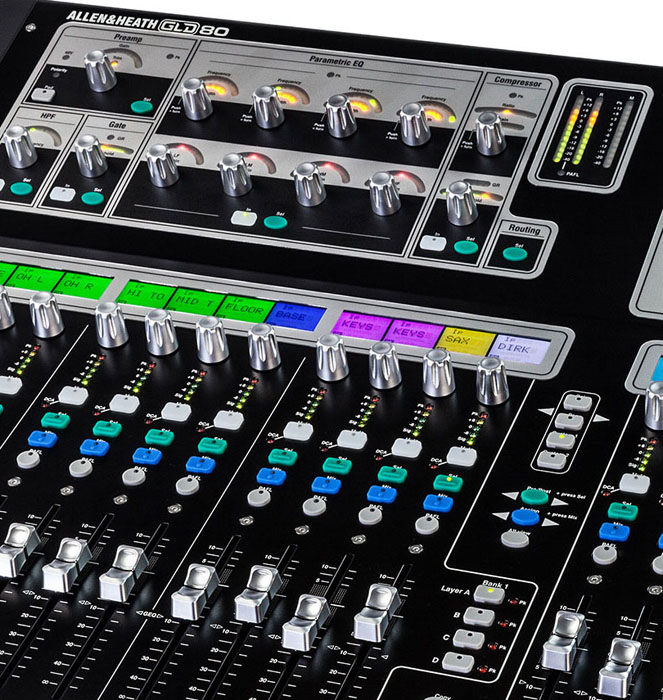
Some consoles may label some auxiliaries as FX or effects sends because they’re intended for use with outboard processing and are configured post fader. Other boards may offer dedicated FX sends that feed the internal effects processing units.
Auxes are quite useful and may be used for feeding monitor mixes, recording feeds or sending audio to delay, fill, and subwoofer loudspeakers. Aux fed subwoofers are a very popular way of reducing low-end problems in sound systems.
A typical PA system usually includes full range boxes and subs, with a crossover splitting the signal between the two. An open mic onstage can pick up low-end rumble, and this will be sent to both the tops and subs in the system. Hard “plosive” consonants from vocalists will also be sent to the subs, and all of this adds up to unwanted energy in the room.
Using a post fader (and usually post EQ) aux, only the channels that the engineer wants in the subs (such as kick drum, floor tom, bass guitar, low speaker on a Leslie, etc.) get sent to the subs. That open mic picking up low end rumble won’t send the mush to the subs unless the engineer routs that signal with the channel aux send. Vocal plosives are reduced as well, with the subs only reproducing what is desired, not whatever leaks in.
Additional Control
Now we’re moving along the channel strip to the pan control and group assignments. On a basic console, the pan control will route audio to both the left and right main outputs evenly when it’s set in the center. Turning the knob to the left or right sends more audio in the direction of the turn and less to the other side.
The pan pot is my best friend at corporate gigs. A typical gig has full-range loudspeakers on stands to each side of the stage or by the walls of the room. The lectern is usually located off to one side of the stage, way closer to one of the loudspeakers. While I can ring out the mains to reduce the susceptibility of feedback, one of my basic approaches is to simply pan the podium and presenter mics toward the loudspeaker that’s further away. In smaller rooms, the audience still hears everything just fine, while the threat of feedback has been reduced.
Consoles with submaster groups offer group selection buttons near the pan knob. When groups are selected, the pan control will route the audio to the odd or even numbered groups, depending on the position of the knob. In the master section, the subgroups can then route the audio to the main left and right outputs or send the audio to independent group outputs.
Submasters are useful for grouping like instruments together, such as drums and guitars, providing an easy way to manage their volume. Submasters are also useful in setting up mixes for recording or sends to remote loudspeakers. Processing such as reverb or compression can also be applied to a submaster group, giving, say, all background vocals the same verb by using the submaster insert points.
Solo and PFL buttons allow listening to a particular channel by itself or along with other soloed channels. PFL stands for Pre Fade Listen and as the name implies, you hear the channel before the fader. Solo (or less commonly called AFL or After Fade Listen) will take the channel’s fader position into account, but many consoles label the PFL as solo.
Some consoles offer “mute” buttons while others offer “on” buttons, and they basically do the same thing in an opposite way. Engaging the mute button silences the channel (or sub-master or mains) that its assigned to. Pushing an on button unmutes the channel.
Larger consoles also have mute groups, which allow the user to assign different inputs and outputs to various groups and recall the mute settings at the touch of a single button. This comes in very handy if there are different musicians or different actors appearing onstage at various times. I used mute groups a lot when I mixed musical theater, placing all of the chorus mics on one group, and various actors on different groups. As the play went on, I would unmute groups of mics with the touch of a single button and not miss a beat.
Remote Control
Our last stop along the chain is the channel fader that controls the master volume for the channel, and it affects all of the audio except pre fader sends. Larger analog and most digital consoles offer VCAs (Voltage Controlled Amplifiers), which are also called DCAs (Digital Controlled Amplifiers) in some digital models.
These controllers don’t pass audio but instead remotely control the position of the channel faders. Submasters are great for grouping channels, but every time a channel is added to a subgroup, another gain stage is added, and every time a channel is added to more than one subgroup, there’s an increase in volume.
VCAs work differently in that they remotely control just the channel’s fader position, and more than one VCA can be assigned to the same channel. The user can group drums, drums and bass, entire band, and entire band with vocals on four different VCAs without adding any gain to the signal while also putting a large number of channel volumes under one finger. On digital consoles that have hidden channel layers, this is a great way to bring groups of inputs to a single layer.
Digital boards may offer additional processing like compression, noise gates, or even audio delay to a channel, as well as the ability to patch in additional processing. But no matter the size or style of console, the basics always remain the same, and by understanding the basics, you can usually get through a gig even if you’re unfamiliar with the desk.
Senior contributing editor Craig Leerman is the owner of Tech Works, a production company based in Las Vegas.

